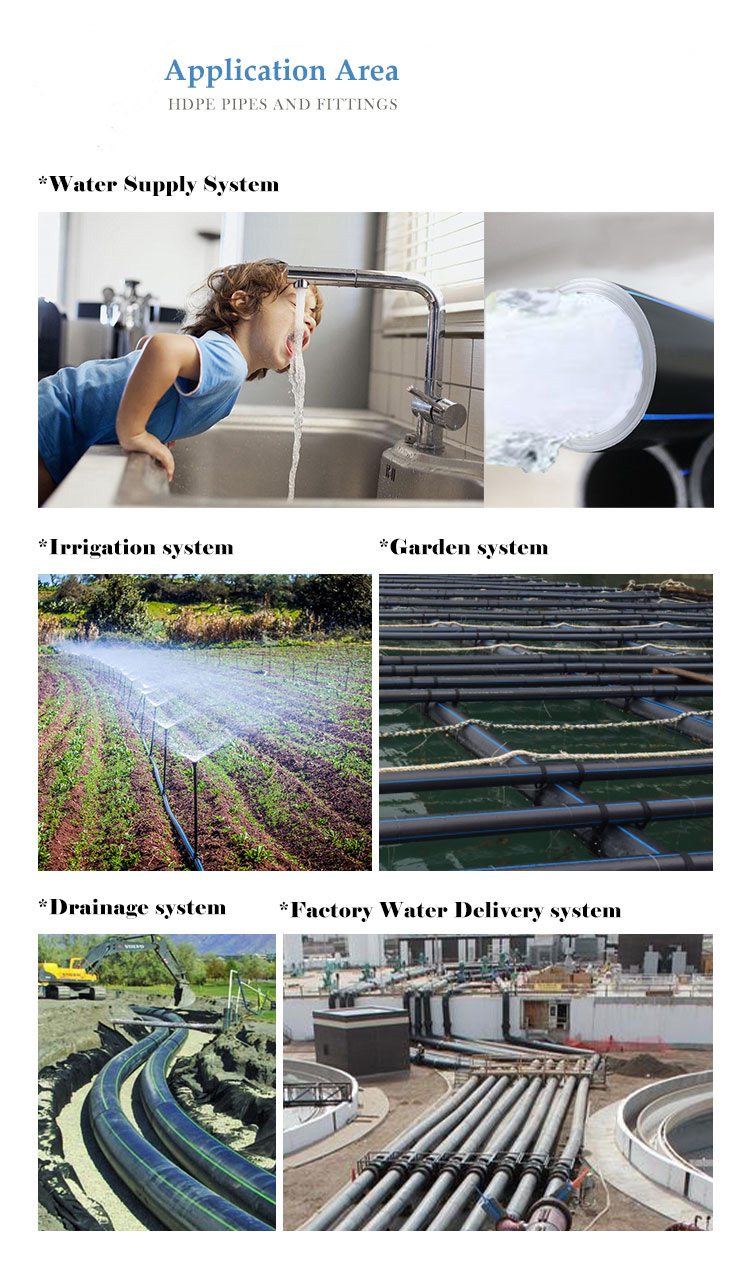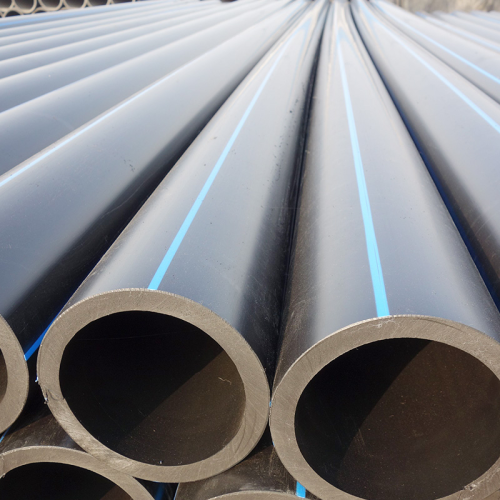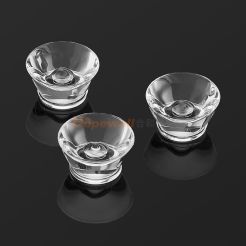HDPE Water Pipe
HDPE water pipe for sale, HDPE water pipe is a solution for public and private drinking water systems, Contact us for prices.
Product Description
Product Description
HDPE water pipe is made from high-density polyethylene resin, which belongs to flexible plastic pipes. HDPE water pipes have good rigidity and toughness, excellent corrosion resistance and high impermeability and strong molecular bond help them to have the high mechanical strength to bear high pressure. HDPE water pipes are usually used for fluid transmissions, such as water, rural irrigation, seawater and drainage, etc.
HDPE (High-Density Polyethylene) water pipes are commonly used in water supply systems due to their high durability, corrosion resistance, and flexibility. HDPE pipes have several advantages over traditional piping materials like metal, concrete, or PVC, including their ability to withstand high pressure, temperature, and impact.
One of the main benefits of HDPE water pipes is their ability to resist corrosion and chemical reactions, making them an ideal choice for water supply systems. Additionally, HDPE pipes are lightweight, making them easy to transport and install. They are also flexible, which allows them to withstand ground movements and settle with soil movement without breaking or leaking.
In terms of installation, HDPE pipes can be joined together using various methods such as butt fusion, electrofusion, or mechanical fittings, which are easy to use and require minimal expertise. The jointing methods create a seamless, leak-proof connection between the pipes, ensuring long-term reliability and reduced maintenance costs.
Main Features of HDPE water pipes
1. Long working life. Minimum 50 years of life under normal conditions.
2. Hygiene. PE pipes are nontoxic, without the composition of heavy metal additives. No scale, no breeding germ, and no second pollution to the potable water.
3. High resistance to attack from various types of chemicals. No electrochemical corrosion.
4. Smooth internal surface. Extremely low friction coefficient. Improved capability for media to pass through. Excellent abrasive resistance.
5. Good flexibility, and high resistance to impact. Resistance to earthquake and twisting.
6. Lightweight, easy to transport, and convenient installation.
7. Unique electro-fusion welding and butt welding make the joints stronger than the material, to guarantee a safe and reliable joint.
8. Simple welding technique, convenient installation. The total cost is low for the installation.
9. Polyethylene water pipes are produced in black, black with blue stripes and blue, etc.
Use
-Where can HDPE pipes be used?
> Urban area water-supply work system;
> Fire-fighting water transmission pipe;
> Landscaping water supply network;
> Agricultural irrigation pipe;
> Drainage and dewatering pipeline
> Trenchless pipelines under roads or bridges

Specifications
-HDPE water pipe specifications
|
HDPE Water Pipe Specifications |
|||||
|
Specification |
SDR26 |
SDR21 |
SDR17 |
SDR13.6 |
SDR11 |
|
Pressure |
0.6Mpa |
0.8Mpa |
1.0Mpa |
1.25Mpa |
1.6Mpa |
|
DN(mm) |
thickness (mm) |
thickness (mm) |
thickness (mm) |
thickness (mm) |
thickness (mm) |
|
20 |
|
|
|
|
2.3 |
|
25 |
|
|
|
|
2.3 |
|
32 |
|
|
|
|
3.0 |
|
40 |
|
|
|
|
3.7 |
|
50 |
|
|
|
|
4.6 |
|
63 |
|
|
|
4.7 |
5.8 |
|
75 |
|
|
4.5 |
5.6 |
6.8 |
|
90 |
|
4.3 |
5.4 |
6.7 |
8.2 |
|
110 |
4.2 |
5.3 |
6.6 |
8.1 |
10.0 |
|
125 |
4.8 |
6.0 |
7.4 |
9.2 |
11.4 |
|
140 |
5.4 |
6.7 |
8.3 |
10.3 |
12.7 |
|
160 |
6.2 |
7.7 |
9.5 |
11.8 |
14.6 |
|
180 |
6.9 |
8.6 |
10.7 |
13.3 |
16.4 |
|
200 |
7.7 |
9.6 |
11.9 |
14.7 |
18.2 |
|
225 |
8.6 |
10.8 |
13.4 |
16.6 |
20.5 |
|
250 |
9.6 |
11.9 |
14.8 |
18.4 |
22.7 |
|
280 |
10.7 |
13.4 |
16.6 |
20.6 |
25.4 |
|
315 |
12.1 |
15.0 |
18.7 |
23.2 |
28.6 |
|
355 |
13.6 |
16.9 |
21.1 |
26.1 |
32.2 |
|
400 |
15.3 |
19.1 |
23.7 |
29.4 |
36.3 |
|
450 |
17.2 |
21.5 |
26.7 |
33.1 |
40.9 |
|
500 |
19.1 |
23.9 |
29.7 |
36.8 |
45.4 |
|
560 |
21.4 |
26.7 |
33.2 |
41.2 |
50.8 |
|
630 |
24.1 |
30.0 |
37.4 |
46.3 |
57.2 |
|
710 |
27.2 |
33.9 |
42.1 |
52.2 |
64.5 |
|
800 |
30.6 |
38.1 |
47.4 |
58.8 |
72.6 |
|
900 |
34.4 |
42.9 |
53.3 |
66.2 |
81.7 |
|
1000 |
38.2 |
44.7 |
59.3 |
72.5 |
90.2 |
|
1200 |
46.3 |
57.2 |
70.6 |
88.2 |
|
-Technical parameters of HDPE water pipes
|
Physical Properties of HDPE water pipe |
||
|
Elongation at break of HDPE pipe |
≥350 % |
ISO 6259 |
|
Longitudinal reversion of HDPE pipe (100±2℃) |
≤3% |
ISO 2505 |
|
Oxidation induction time of HDPE pipe (200℃) |
≥20min. |
ISO 11357-6:2002
|
|
Melt Flow Rate of HDPE pipe (5Kg,190℃,10min.) |
Change of MFR by processing±20% |
ISO 1133:2005 |
|
Mechanical Properties of HDPE Pipe |
|||
|
Hydrostatic strength of HDPE pipe at 20℃
|
For PE100 Pipe |
20℃, 100h, 12.4Mpa No leak, No break |
ISO 1167 |
|
Hydrostatic strength of HDPE pipe at 80℃
|
For PE100 Pipe |
80℃, 165h, 5.4Mpa No leak, No break |
ISO 1167 |
Components for HDPE water pipes
-Package included 8.8 grade galvanized bolts and nuts, rubber gaskets for the connection of the pipelines
-Optional butt fusion welding machine, stub device, crane hoist
History of the development of HDPE pipes
High-density polyethylene (HDPE) pipes were first introduced in the 1950s as an alternative to traditional piping materials such as concrete, steel, and clay. HDPE pipes were initially used in the gas and oil industry for transporting fluids under high-pressure and corrosive environments.
In the 1960s, HDPE pipes were further developed and began to be used in water distribution systems. They were found to be highly durable, lightweight, and resistant to corrosion, making them a popular choice for water distribution systems in urban areas.
During the 1970s and 1980s, HDPE pipe production expanded rapidly, with improvements in manufacturing processes and growing demand for the material in various industries. The pipes were also found to be useful in applications such as sewage and stormwater management, as well as in agricultural irrigation systems.
Advancements in HDPE pipe technology continued into the 1990s and 2000s, with the introduction of new manufacturing techniques that further improved the strength, durability, and flexibility of the pipes. These advances made HDPE pipes even more versatile, with the ability to handle a wider range of temperatures, pressures, and chemical exposures.
Today, HDPE pipes are widely used in a variety of applications, including water supply and distribution, gas distribution, wastewater management, mining, and industrial piping systems. Their durability, flexibility, and resistance to corrosion and abrasion make them a popular choice for many different types of piping systems.

